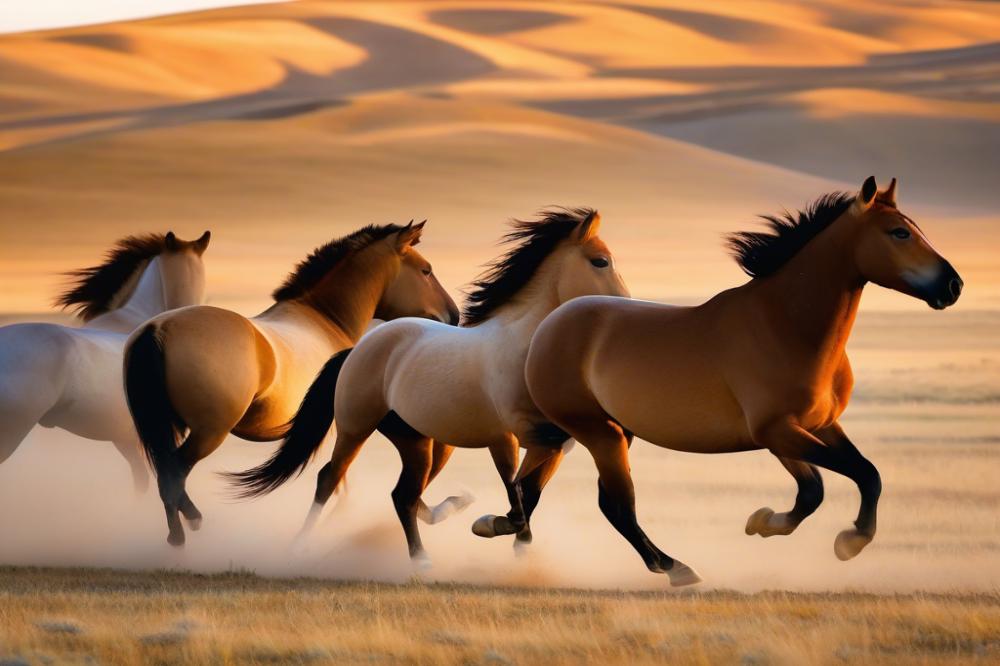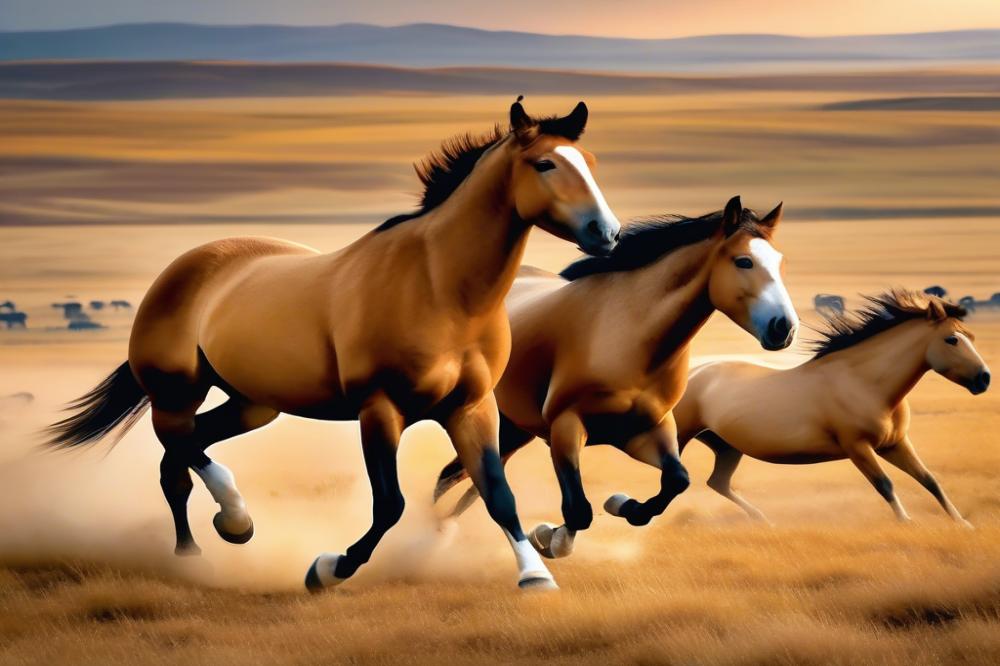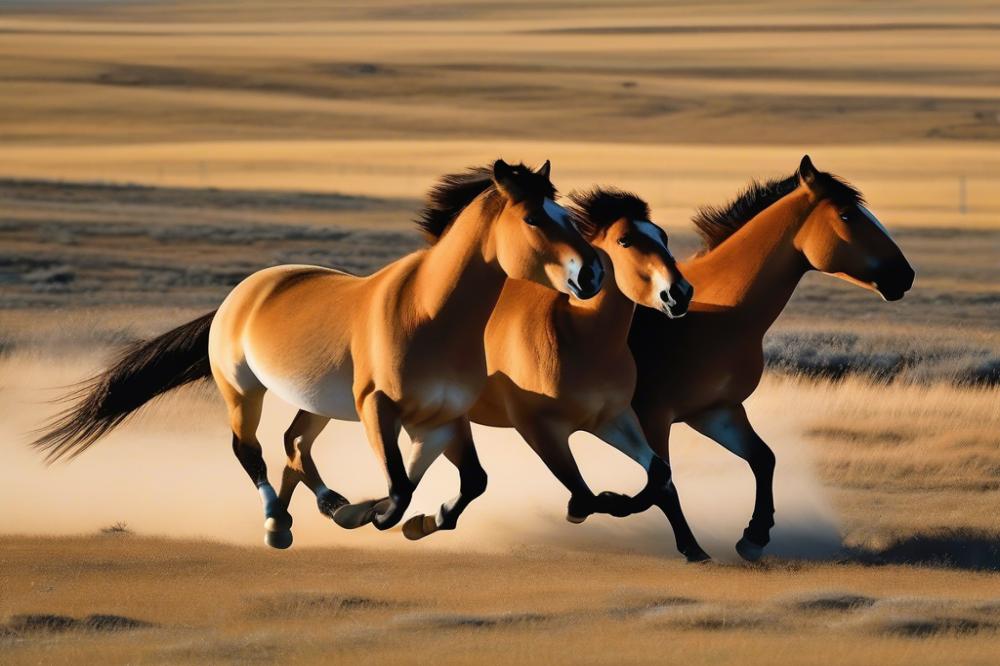Mongolia’s Przewalski’s Horses: From extinction to Freedom in the Steppe
Overview of Przewalski’s Horses
Przewalski’s Horses, a rare and fascinating species, hold a special place in the hearts of conservationists and animal lovers alike. Native to the grasslands of Central Asia, they represent the last truly wild horse population on Earth. Unlike domesticated horses, these creatures have a rich history rooted in the untamed landscapes of Mongolia. Their distinctive appearance, characterized by a stocky build and an erect mane, sets them apart from their domestic relatives.
The species plays an essential role in understanding feral horse populations globally. Their survival and adaptation in harsh environments serve as a crucial point of study for wildlife enthusiasts. Observing their behavior helps scientists gain insights into the ecological dynamics of grassland ecosystems. By studying their interactions and lifestyle, we can learn more about the delicate balance of nature.
Unfortunately, Przewalski’s Horses faced a dire fate in the 20th century. Habitat loss, hunting, and competition with livestock pushed them to the brink of extinction. By the 1960s, they existed only in captivity. However, the tides began to change. conservation efforts took shape as dedicated individuals and organizations worked tirelessly to protect and reintroduce these remarkable animals into their natural habitat. Today, these horses roam the steppes of Mongolia once more, a testament to the power of hope and perseverance in wildlife conservation.
History of Przewalski’s Horses

Origin and distribution in Central Asia
Przewalski’s horses, a wild equine species, are native to Central Asia. Their historical range included regions of Mongolia, northern China, and parts of Kazakhstan. These horses are the last truly wild horse population in the world. Unlike domestic horses, they do not descend from domesticated species. They play a vital role in the ecosystems where they roam. Their hardy nature allowed them to adapt to harsh steppe environments, thriving wherever grasslands existed.
Factors leading to extinction in the wild
Over time, several factors contributed to their alarming decline. Habitat loss due to agriculture and urban development greatly impacted them. Human activities disrupted their natural habitats. Additionally, hunting reduced their numbers significantly. By the mid-20th century, they were declared extinct in the wild. This sad status resulted from a combination of these pressures. It illustrated the vulnerability of species facing rapid environmental changes.
Role of captive breeding programs in conservation efforts
In response to their plight, conservationists took action. Captive breeding programs began around the 1950s. Zoos and wildlife reserves worked together to save the species from extinction. These efforts involved carefully controlled breeding to increase population numbers. Success came slowly, but these programs laid the groundwork for future reintroductions into the wild. In the late 20th century, initiatives began to release these horses into their native habitats.
Reintroduction into areas of Mongolia was particularly significant. Today, populations are being steadily reestablished in the wild. While challenges remain, these efforts show promising signs. Hope remains for the survival of this remarkable species.
Conservation Efforts and Rewilding

Overview of wildlife protection initiatives
Many organizations have worked hard to protect Mongolia’s wildlife. They focus on creating habitats for various species. Governments and non-profits collaborate to establish conservation areas. These efforts are crucial in safeguarding the natural environment. Education programs help local communities understand the importance of wildlife. Such initiatives aim to create a balance between nature and human activity.
Significance of rewilding for Przewalski’s Horses
Rewilding plays a key role in restoring ecosystems. It helps reintroduce species into their natural habitats. This process is vital for the survival of animals once considered extinct in the wild. Rewilding initiatives offer a second chance for these magnificent creatures. Such projects not only support animal populations, but they also promote biodiversity. A healthier ecosystem is beneficial for all wildlife.
Success stories and the establishment of protected areas in Mongolia
Mongolia has made significant strides in wildlife conservation. Protected areas have been established across the country to preserve habitats. These regions foster the growth of various species. The commitment demonstrated by local communities bolsters these efforts. Successful rewilding programs have shown positive outcomes. Many animals have been able to thrive in their renewed environments. Conservationists continue to push for more extensive and better-protected areas. The progress witnessed in Mongolia serves as an encouraging example for global wildlife preservation.
Przewalski’s Horses and the Steppe Ecosystem
These horses play a vital role in the biodiversity of steppe regions. Their grazing habits help to shape the landscape. By consuming various grasses, they create space for other plant species. This supports a wide range of organisms that rely on these plants for survival.
Interactions with delicate flora and fauna in Central Asia are significant. Many animals and insects depend on the habitats formed by plant diversity. As these horses roam the steppe, they influence seed dispersal. Their movement helps plants to spread across vast areas, thereby enriching the ecosystem.
Ecological restoration efforts often look to these equines for guidance. Reintroducing Przewalski’s horses can help rehabilitate degraded lands. As they thrum across the plains, their presence revitalizes the soil. With their help, native plant species can flourish again.
This horse’s existence also fosters a balance within the ecosystem. Removing predators from the ecosystem could spell disaster, as unchecked populations can lead to overgrazing. However, in their natural habitat, they serve as part of a larger food web. This balance is crucial for maintaining healthy steppe environments.
Each aspect of their life contributes to the richness of the steppe. From their grazing to their breeding patterns, every activity impacts the landscape. Other wildlife thrives when these unique horses roam freely. Respecting their presence ultimately benefits many species that share their home.
Current Status and Future Prospects
Population recovery of Przewalski’s Horses has shown promising results in recent years. Once declared extinct in the wild, this species now roams the grasslands of Mongolia once again. As of the latest counts, there are around 2,000 individuals in various reserves and national parks. Monitoring these animals is key to their survival. Conservation teams regularly track their movements and health. This ensures that the population continues to grow and thrive.
Challenges Faced in the Wild
Despite the success in breeding programs, challenges still exist in the wild. Habitat loss threatens their natural living spaces. Climate change impacts the availability of food and water sources. Additionally, poaching plays a major role in their struggle for survival. Illegal hunting remains an issue in some regions. Without protective measures, the future can seem uncertain.
Ongoing Conservation Efforts
Many organizations work hard to protect these horses and their habitats. Ranger patrols help deter poachers while educating local communities about the importance of conservation. Creating protected areas is another strategy. These zones aim to provide a secure habitat for the horses to thrive. Collaborative efforts between government and non-profits show promise for future initiatives.
The Importance of Community Involvement
Community involvement is vital for the success of wildlife protection efforts. Local people are often the first to notice changes in animal populations or illegal activities. Educating them about conservation benefits everyone. When locals understand the value of these horses, they tend to become better stewards of the land. Economic incentives, such as eco-tourism, can provide communities with alternative livelihoods. Sustainable practices promote harmony between people and wildlife.
Reflecting on a Journey Towards Freedom
The story of Mongolia’s Przewalski’s Horses is one of hope and determination. Once on the brink of extinction, these animals have seen a remarkable resurgence. Years of dedicated conservation efforts by scientists, organizations, and local communities have contributed to their return to the wild. This journey reveals the power of teamwork and the importance of preserving biodiversity in our world.
Thinking back on their journey, we recognize the lessons learned. The recovery of this species highlights the resilience of nature when given support. It reminds us that every effort counts. Every initiative to protect wildlife plays a role in safeguarding the future. Awareness in feral horse conservation efforts is crucial for the species and the education of future generations.
Przewalski’s Horses symbolize the challenges faced by many endangered species today. They are a reminder of what can happen when human actions lead to habitat loss and population decline. Their story emphasizes our responsibility to not only acknowledge past mistakes but also to work toward a better future. As we celebrate their freedom, we must also recognize the ongoing threats to their survival.
Support for ongoing conservation efforts remains vital. People can contribute by engaging with local conservation groups, spreading awareness, and advocating for protected habitats. The journey is not over, and the fight must continue. Every action taken can make a difference in ensuring these unique horses thrive for generations to come.
Now is the time to act. The success of our planet’s biodiversity depends on collective commitment and action. Working together, we can celebrate not only the freedom of these horses but also a future where all species can flourish alongside one another.



